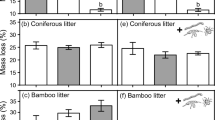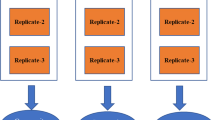Abstract
Litter decomposition is the main source of mineral nitrogen (N) in terrestrial ecosystem and a key step in carbon (C) cycle. Microbial community is the main decomposer, and its specialization on specific litter is considered at the basis of higher decomposition rate in its natural environment than in other forests. However, there are contrasting evidences on how the microbial community responds to a new litter input and if the mass loss is higher in natural environment. We selected leaf litter from three different plant species across three sites of different altitudinal ranges: oak (Quercus petraea (Matt.) Liebl., 530 m a.s.l), beech (Fagus sylvatica L., 1000 m a.s.l.), rhododendron (Rhododendron ferrugineum L., 1530 m a.s.l.). A complete transplantation experiment was set up within the native site and the other two altitudinal sites. Microbial community structure was analyzed via amplified ribosomal intergenic spacer analysis (ARISA) fingerprinting. Functionality was investigated by potential enzyme activities. Chemical composition of litter was recorded. Mass loss showed no faster decomposition rate on native site. Similarly, no influence of site was found on microbial structure, while there was a strong temporal variation. Potential enzymatic activities were not affected by the same temporal pattern with a general increase of activities during autumn. Our results suggested that no specialization in microbial community is present due to the lack of influence of the site in structure and in the mass loss dynamics. Finally, different temporal patterns in microbial community and potential enzymatic activities suggest the presence of functional redundancy within decomposers.






Similar content being viewed by others
References
Sayer EJ (2006) Using experimental manipulation to assess the roles of leaf litter in the functioning of forest ecosystems. Biol Rev 81:1–31
Cotrufo MF, De Angelis P, Polle A (2005) Leaf litter production and decomposition in a poplar short-rotation coppice exposed to free air CO2 enrichment (POPFACE). Glob Chang Biol 11:971–982
Berg B, McClaugherty C (2008) Plant litter. Decomposition, humus formation, carbon sequestration. Springer, US
Parton W, Silver WL, Burke IC, Grassens L, Harmon ME, Currie WS, King JY, Adair EC, Brandt LA, Hart SC, Fasth B (2007) Global-scale similarities in nitrogen release patterns during long-term decomposition. Science 315:361–364
de Boer W, Folman LB, Summerbell RC, Boddy L (2005) Living in a fungal world: impact of fungi on soil bacterial niche development. FEMS Microbiol Rev 29:795–811
van der Wal A, Geydan TD, Kuyper TW, de Boer W (2013) A thready affair: linking fungal diversity and community dynamics to terrestrial decomposition processes. FEMS Microbiol Rev 37:477–494
Rytioja J, Hilden K, Yuzon J, Hatakka A, de Vries RP, Makela MR (2014) Plant-polysaccharide-degrading enzymes from basidiomycetes. Microbiol Mol Biol Rev 78:614–649
Purahong W, Wubet T, Lentendu G, Schloter M, Pecyna MJ, Kapturska D, Hofrichter M, Kruger D, Buscot F (2016) Life in leaf litter: novel insights into community dynamics of bacteria and fungi during litter decomposition. Mol Ecol 25:4059–4074
Tlaskal V, Voriskova J, Baldrian P (2016) Bacterial succession on decomposing leaf litter exhibits a specific occurrence pattern of cellulolytic taxa and potential decomposers of fungal mycelia. FEMS Microbiol Ecol 92(11):fiw177
Lladó S, López-Mondéjar R, Baldrian P (2017) Forest soil bacteria: diversity, involvement in ecosystem processes, and response to global change. Microbiol Mol Biol Rev 81:e00063-00016
Bugg TD, Ahmad M, Hardiman EM, Singh R (2011) The emerging role for bacteria in lignin degradation and bio-product formation. Curr Opin Biotechnol 22:394–400
López-Mondéjar R, Zühlke D, Becher D, Riedel K, Baldrian P (2016) Cellulose and hemicellulose decomposition by forest soil bacteria proceeds by the action of structurally variable enzymatic systems. Sci Rep 6:25279
Snajdr J, Cajthaml T, Valaskova V, Merhautova V, Petrankova M, Spetz P, Leppanen K, Baldrian P (2011) Transformation of Quercus petraea litter: successive changes in litter chemistry are reflected in differential enzyme activity and changes in the microbial community composition. FEMS Microbiol Ecol 75:291–303
Peršoh D, Segert J, Zigan A, Rambold G (2013) Fungal community composition shifts along a leaf degradation gradient in a European beech forest. Plant Soil 362:175–186
Voriskova J, Baldrian P (2013) Fungal community on decomposing leaf litter undergoes rapid successional changes. ISME J 7:477–486
Fioretto A, Papa S, Curcio E, Sorrentino G, Fuggi A (2000) Enzyme dynamics on decomposing leaf litter of Cistus incanus and Myrtus communis in a Mediterranean ecosystem. Soil Biol Biochem 32:1847–1855
Frossard A, Gerull L, Mutz M, Gessner MO (2012) Disconnect of microbial structure and function: enzyme activities and bacterial communities in nascent stream corridors. ISME J 6:680–691
Purahong W, Schloter M, Pecyna MJ, Kapturska D, Daumlich V, Mital S, Buscot F, Hofrichter M, Gutknecht JL, Kruger D (2014) Uncoupling of microbial community structure and function in decomposing litter across beech forest ecosystems in Central Europe. Sci Rep 4:7014
Aneja MK, Sharma S, Fleischmann F, Stich S, Heller W, Bahnweg G, Munch JC, Schloter M (2006) Microbial colonization of beech and spruce litter—influence of decomposition site and plant litter species on the diversity of microbial community. Microb Ecol 52:127–135
Gavazov K, Mills R, Spiegelberger T, Lenglet J, Buttler A (2014) Biotic and abiotic constraints on the decomposition of Fagus sylvatica leaf litter along an altitudinal gradient in contrasting land-use types. Ecosystems 17:1326–1337
Xu Z, Yu G, Zhang X, Ge J, He N, Wang Q, Wang D (2015) The variations in soil microbial communities, enzyme activities and their relationships with soil organic matter decomposition along the northern slope of Changbai Mountain. Appl Soil Ecol 86:19–29
Vivanco L, Austin AT (2008) Tree species identity alters forest litter decomposition through long-term plant and soil interactions in Patagonia, Argentina. J Ecol 96:727–736
Strickland MS, Osburn E, Lauber C, Fierer N, Bradford MA (2009) Litter quality is in the eye of the beholder: initial decomposition rates as a function of inoculum characteristics. Funct Ecol 23:627–636
Thoms C, Gattinger A, Jacob M, Thomas FM, Gleixner G (2010) Direct and indirect effects of tree diversity drive soil microbial diversity in temperate deciduous forest. Soil Biol Biochem 42:1558–1565
Urbanová M, Šnajdr J, Baldrian P (2015) Composition of fungal and bacterial communities in forest litter and soil is largely determined by dominant trees. Soil Biol Biochem 84:53–64
Šnajdr J, Dobiášová P, Urbanová M, Petránková M, Cajthaml T, Frouz J, Baldrian P (2013) Dominant trees affect microbial community composition and activity in post-mining afforested soils. Soil Biol Biochem 56:105–115
Veen GF, Sundqvist MK, Wardle DA (2015) Environmental factors and traits that drive plant litter decomposition do not determine home-field advantage effects. Funct Ecol 29:981–991
Rauzi GM (1963) Indagine chimico-comparativa fra terreni e foraggi dell’Alto Adige e suoi riflessi nel campo agronomico e zootecnico. Accademia Roveretana degli Agiati di Scienze, Lettere ed Arti, Atti serie VI, 3B:39–64 (in Italian)
Pertoll G, Pedri U, di Laimburg C d SA, Kobler A, Kobler W (2012) Lagrein: influenza del sito di coltivazione, del terreno e delle modalità di coltivazione sulla qualità dell’uva e del vino. Frutta e Vite 36:58–63
Cornelissen JHC, Lavorel S, Garnier E, Dìaz S, Buchmann N, Gurvich DE, Reich PB, Ht S, Morgan HD, MGAvd H, Pausas JG, Poorter H (2003) A handbook of protocols for standardised and easy measurement of plant functional traits worldwide. Aust J Bot 51:335–380
Cardinale M, Brusetti L, Quatrini P, Borin S, Puglia AM, Rizzi A, Zanardini E, Sorlini C, Corselli C, Daffonchio D (2004) Comparison of different primer sets for use in automated ribosomal intergenic spacer analysis of complex bacterial communities. Appl Environ Microbiol 70:6147–6156
Carson JK, Gleeson DB, Clipson N, Murphy DV (2010) Afforestation alters community structure of soil fungi. Fungal Biol 114:580–584
Borruso L, Zerbe S, Brusetti L (2015) Bacterial community structures as a diagnostic tool for watershed quality assessment. Res Microbiol 166:38–44
Bardelli T, Gómez-Brandón M, Ascher-Jenull J, Fornasier F, Arfaioli P, Francioli D, Egli M, Sartori G, Insam H, Pietramellara G (2017) Effects of slope exposure on soil physico-chemical and microbiological properties along an altitudinal climosequence in the Italian Alps. Sci Total Environ 575:1041–1055
Fornasier F, Margon A (2007) Bovine serum albumin ant Triton X-100 greatly increase phosphomonoesterases and arylsulphatase extraction yield from soil. Soil Biol Biochem 39:2682–2684
Fornasier F, Ascher J, Ceccherini MT, Tomat E, Pietramellara G (2014) A simplified rapid, low-cost and versatile DNA-based assessment of soil microbial biomass. Ecol Indic 45:75–82
Dixon P (2003) VEGAN, a package of R functions for community ecology. J Veg Sci 14(6):927–930
Purahong W, Kapturska D, Pecyna MJ, Schulz E, Schloter M, Buscot F, Hofrichter M, Kruger D (2014) Influence of different forest system management practices on leaf litter decomposition rates, nutrient dynamics and the activity of ligninolytic enzymes: a case study from central European forests. PLoS One 9:e93700
Fox J, Weisberg S (2011) An R companion to applied regression. Sage, CA
Sosnovsky Y, Nachychko V, Prokopiv A, Honcharenko V (2017) Leaf architecture in Rhododendron subsection Rhododendron (Ericaceae) from the Alps and Carpathian Mountains: taxonomic and evolutionary implications. Flora 230:26–38
Sariyildiz T, Anderson J (2005) Variation in the chemical composition of green leaves and leaf litters from three deciduous tree species growing on different soil types. For Ecol Manag 210:303–319
Makkonen M, Berg MP, Handa IT, Hättenschwiler S, Ruijven J, Bodegom PM, Aerts R (2012) Highly consistent effects of plant litter identity and functional traits on decomposition across a latitudinal gradient. Ecol Lett 15:1033–1041
van Dorst J, Bissett A, Palmer AS, Brown M, Snape I, Stark JS, Raymond B, McKinlay J, Ji M, Winsley T (2014) Community fingerprinting in a sequencing world. FEMS Microbiol Ecol 89:316–330
Pioli S, Antonucci S, Giovannelli A, Traversi ML, Borruso L, Bani A, Brusetti L, Tognetti R (2018) Community fingerprinting reveals increasing wood-inhabiting fungal diversity in unmanaged Mediterranean forests. For Ecol Manag 408:202–210
Borruso L, Esposito A, Bani A, Ciccazzo S, Papa M, Zerbe S, Brusetti L (2017) Ecological diversity of sediment rhizobacteria associated with Phragmites australis along a drainage canal in the Yellow River watershed. J Soils Sediments 17:253–265
Purahong W, Kapturska D, Pecyna MJ, Jariyavidyanont K, Kaunzner J, Juncheed K, Uengwetwanit T, Rudloff R, Schulz E, Hofrichter M, Schloter M, Kruger D, Buscot F (2015) Effects of forest management practices in temperate beech forests on bacterial and fungal communities involved in leaf litter degradation. Microb Ecol 69:905–913
Loreau M (2004) Does functional redundancy exist? Oikos 104:606–611
Větrovský T, Steffen KT, Baldrian P (2014) Potential of cometabolic transformation of polysaccharides and lignin in lignocellulose by soil Actinobacteria. PLoS One 9:e89108
Cornwell WK, Cornelissen JH, Amatangelo K, Dorrepaal E, Eviner VT, Godoy O, Hobbie SE, Hoorens B, Kurokawa H, Perez-Harguindeguy N, Quested HM, Santiago LS, Wardle DA, Wright IJ, Aerts R, Allison SD, van Bodegom P, Brovkin V, Chatain A, Callaghan TV, Diaz S, Garnier E, Gurvich DE, Kazakou E, Klein JA, Read J, Reich PB, Soudzilovskaia NA, Vaieretti MV, Westoby M (2008) Plant species traits are the predominant control on litter decomposition rates within biomes worldwide. Ecol Lett 11:1065–1071
John MGS, Orwin KH, Dickie IA (2011) No ‘home’versus ‘away’effects of decomposition found in a grassland–forest reciprocal litter transplant study. Soil Biol Biochem 43:1482–1489
Dilly O, Bloem J, Vos A, Munch JC (2004) Bacterial diversity in agricultural soils during litter decomposition. Appl Environ Microbiol 70:468–474
Acknowledgements
We thank Dr. Christian Ceccon for C and N quantification, and Dr. Maurizio Ventura for providing the data information of Monticolo site. This work was supported by the internal grant by the Free University of Bozen/Bolzano entitled “Leaves degradation in mountain environments - LeDEME” (CUP I52I14000410005). We thank Prof. Giustino Tonon for the access to the Monticolo site area, managed under the NITROFOR project.
Author information
Authors and Affiliations
Contributions
LBr conceived the study. AB, LB, SP and CW conducted the fieldwork. AB conducted the molecular and chemical analysis, AB and FF performed enzyme analysis. Statistical analysis was performed by AB and LB. AB drafted the manuscript. All authors read, edited and approved the manuscript.
Corresponding author
Rights and permissions
About this article
Cite this article
Bani, A., Borruso, L., Fornasier, F. et al. Microbial Decomposer Dynamics: Diversity and Functionality Investigated through a Transplantation Experiment in Boreal Forests. Microb Ecol 76, 1030–1040 (2018). https://doi.org/10.1007/s00248-018-1181-5
Received:
Accepted:
Published:
Issue Date:
DOI: https://doi.org/10.1007/s00248-018-1181-5




